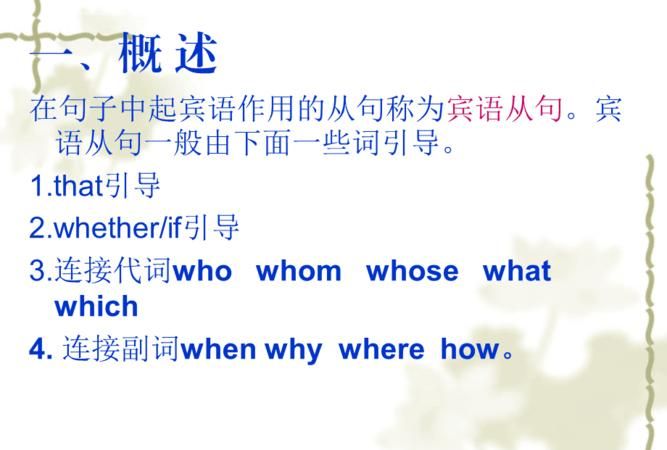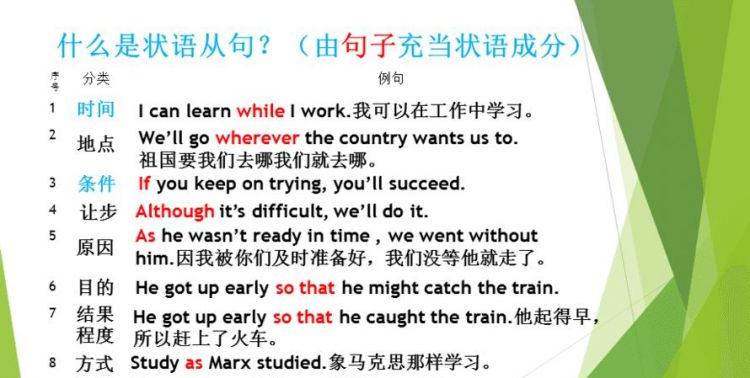本文目录
初中英语定语从句专项训练
定语从句
定语是指在句子中用来修饰名词、代词的成分
如:I will give my teacher a bunch of beautiful flower. (中beautiful就是定语)
定语从句是指在一个句子中作定语的句子,定语从句要放在所修饰的词后
如:I have met the doctor who is in the No.1 hospital.
定语从句的连接词:
连接代词:who、which、whom、whose、that
连接副词:when、where、why
一. 定语从句的功用和结构
在复合句中,修饰某一名词或代词的从句叫做定语从句。被定从句修饰的词叫做先行词。定语从句必须放在先行词之后。引导定语从句的关联词有关系代词和关系副词。例如:
This is the present that he gave me for my birthday. Do you know everybody who came to the party?
I still remember the night when I first came to the village? This is the place where Chairman Mao once lived.
关系代词和关系副词的功用
关系代词和关系副词用来引导定于从句,在先行词和定语从句之间起纽带作用,使二者联系起来。关系代词和关系副词又在定语从句中充当一个成分。关系待客做主语,宾语,定语,关系副词可作状语。
作主语:关系代词在定语从句中作主语时,从句的谓语动词的人称和数须和先行词一致。例如:
I don’t like people who talk much but do little. The cars which are produced in Hubei Province sell very well.
2. 作宾语:
She is the person that I met at the school gate yesterday. The book that my grandmother gave me is called “The Great Escape”.
3. 作定语
关系代词whose在定语从句中作定语用。例如:
What’s the name of the young man whose sister is a doctor? The girl whose father is a teacher studies very hard.
4. 作状语
I’ll never forget the day when I first came to Beijing. This is the house where I was born.
各个关系代词和关系副词的具体用法
1. who 指人,在定语从句中作主语。例如:
The person who broke the window must pay for it. The boy who is wearing the black jacket is very clever.
2. whom指人,在定语从句中作宾语。例如:
Do you know the young man (whom) we met at the gate? Mr Lee (whom) you want to see has come.
3. whose 指人,在定语从句中作定语。例如:
The girl whose mother is ill is staying at home today. I know the boy whose father is a professor.
4. which指物,在定语从中作主语或宾语。例如:
A dictionary is a book which gives the meaning of words. Here is the book (which) the teacher mentioned yesterday.
5.that多指物,有时也指人,在定语从句中作主语或宾语。例如:
I’ve read the newspaper that(which) carries the important news. Who is the person that is reading the newspaper over there?
6. when 指时间,在定语从句中作状语。例如:
I’ll never forget the time when we worked on the farm. He arrived in Beijing on the day when I left.
7. where 指地点,在定语从句中作状语。例如:
This is the house where we lived last year. The factory where his father works is in the east of the city
四. 关系代词 whom, which 在定语从句中作介词宾语时,可以和介词一起放于先行词与定语从句之间,有时为了关系紧凑也可以将 whom 与 which 与先行词紧挨着书写,而将介词置于定语从句的后面,如:
That was the room in which we had lived for ten years. = That was the room which we had lived in for ten years.
五. 具体使用时还要注意下列问题:
1. 只能使用that,不用which 的情况:
(1) 先行词是all, few, little, nothing, everything, anything 等不定代词时。例如: All that he said is true.
(2) 先行词被only, no, any, all,等词修饰时。例如: He is the only foreigner that has been to that place.
(3) 先行词是序数词或被序数词修饰的词。例如: He was the second (person) that told me the secret.
(4) 先行词是形容词最高级或被形容词最高级修饰的词。 This is the best book (that) I have read this year.
(5) 先行词既包括人又包括物时。例如: He talked about the people and the things he remembered.
这是我在上课的时候用的资料。你可以先看看

初中英语宾语从句知识点总结
置于动词、介词等词性后面起宾语作用的从句叫宾语从句。宾语从句的语序必须是陈述语序。下面是我整理的初中英语宾语从句知识点,欢迎大家分享。
一.宾语从句的定义
置于动词、介词等词性后面起宾语作用的从句叫宾语从句。宾语从句的语序必须是陈述语序。谓语动词、介词、动词不定式,v.-ing形式后面都能带宾语从句。有些形容词(afraid,sure,glad等)之后也可以带宾语从句。
二.宾语从句中引导词的用法
在复合句中作主句的宾语,引导词有:
连词:that (that 常可省略),whether, if 。代词:who, whose, what ,which 。副词:when ,where, how, why 等。
(一)that引导的宾语从句(在非正式场合that可以省略)
可跟that从句做宾语的动词有:say, think, insist, wish, hope, demand, imagine, wonder, know, suppose, see, believe, agree, admit, deny, expect, explain, order, command, feel, dream, suggest, hear, mean, notice, prefer, request, require, propose, declare, report等。
例句:The boy believes that he will travel through space to other planets.
注意事项:当主句谓语动词是 think, believe, suppose, expect 等词,而宾语从句的意思是否定时,常把否定转移至主句表示。
例句:I don't think it is right for him to treat you like that.
在以下情况中that不能省略
1当句中的动词后接多于两个由that引导的宾语从句时,第一个that可省,但后面的that不可省。
例句:He said (that) you were too young to understand the matter and that he was asked not to tell you.
2当主句的谓语动词与that宾语从句之间有插入语时,that一般不可省。
例句:Just then I noticed, for the first time, that our master was wearing his fine green coat and his black silk cap.
3当that从句是双宾语中的直接宾语时,that不可省。
例句:I can't tell him that his mother died.
注意事项:许多带复合宾语的句子,that引导的'宾语从句经常移到句子后部,而用it作形式宾语。
例句:I find it necessary that we should do the homework on time.
(二)由whether,if 引导的宾语从句
由whether(if)引导的t宾语从句,实际上是一般疑问句演变而来的。意思是"是否"。宾语从句要用陈述句语序。一般说来,在宾语从句中whether与if可以互换使用,但在特殊情况下if与whether是不能互换的。
例句:I wonder whether(if) they will come to our party.
只能用whether,不能用if引导的宾语从句
1在带to的不定式前
例句:We decided whether to walk there.
1在介词的后面 例句:I'm thinking of whether we should go to see the film.
2在动词后面的宾语从句 例句:We discussed whether we had a sports meeting next week
3直接与or not连用时 例句:I can't say whether or not thet can come on time.
只能用if不能用whether引导的宾语从句
1if引导条件状语从句,意为"如果" 例句:The students will go on a picnic if it is sunny.
2if引导否定概念的宾语从句时 例句:He asked if I didn't come to school yesterday.
3引导状语从句even if(即使)和as if(好象)时 例句:He talks as if he has known all about it.
(三)连接代词和连接副词引导的宾语从句
这样的宾语从句实际上是由特殊疑问句变化而来的,宾语从句要用陈述句语序。用于这种结构的动词常常是:see, say, tell, ask, answer, know, decide, show, find out, imagine, suggest, doubt, wonder, discover, understand, inform, advise等。
英语中的连接代词有:who,whom,whose,which,what,在句中担任主语、宾语、定语或者表语。
例句:Can you tell me whom you are waiting for?
英语中的连接副词有:when,where,why,how,在句中担任状语的成分。
例句:None of us knows where these new parts can be bought.
三.宾语从句的语序
宾语从句的语序是陈述句语序即:连接代词/副词+主语+谓语+其他成分。例句如下:1 I don't know what they are looking for. 2 Could you tell me when the train will leave?
3 Can you imagine what kind of man he is?
四.宾语从句的时态
1主句是一般现在时,从句根据实际情况使用任何时态。例句:The headmaster hopes everything goes well.
2主句是过去时态,从句须用过去时态的某种形式。
例句:She was sorry that she hadn't finished her work on time.
3 当宾语从句表示的是一个客观真理或者事实时,即使主句是过去时,从句也用一般现在时态。
例句:The teacher told his class that light travels faster than sound.
五.宾语从句的特点
1宾语从句可以作及物动词、介词及形容词的宾语。
2宾语从句的语序一律用陈述句语序。
3连接词that引导宾语从句在句中无词义,不充当句子成份,多数情况下可以省略。
4whether 和 if 都可引导宾语从句,但whether后可紧跟or not;whether从句可作介词的宾语。
5如果从句太长,可以用形式宾语it.
英语语法宾语从句细解
介词的宾语从句
用wh-类的介词宾语从句
We are talking about whether we admit students into our club.
我们正在讨论是否让学生加入我们的俱乐部.
The new book is about how Shenzhou 6 manned spaceship was sent up into space.
这本新书是关于神舟6号载人航天飞船是如何升入太空的.
用that,if引导的介词宾语从句
有时候except,but,besides三个介词后可见到that引导的宾语从句
I know nothing about my new neighbor except that he used to work with a company.
对于我的新邻居我只知道他曾在一家公司上班,其他一无所知.
形容词的宾语从句
常用来引导宾语从句的形容词有: sure,certain,glad,please,happy,sorry,afraid,satisfied,surprised
I am sure I will pass the exam.
我确信我会通过考试.
I am sorry that I have troubled you so long.
很抱歉我这么长时间在打扰你.
He is glad that Li Ming went to see him when he was ill.
他很高兴在他生病的时候李明能去看望他.

初中英语定语从句讲解ppt课件
初中英语百度云网盘资源下载地址
链接:***/s/1znmI8mJTas01m1m03zCRfQ
?pwd=1234 提取码:1234
介绍:资源包含各类型初中名师网课,课外辅导、初中中考冲刺、教材、复习文档、学习视频等等资源包罗万象。

初中英语状语从句知识点归纳
状语从句是初中英语学习的重点,也是每年中考必考的内容之一,主要考查引导状语从句的连词、从句时态等方面。重点考查时间状语从句、条件状语从句、结果状语从句和比较状语从句。
家长们想让孩子掌握好这些从句,选阿卡索这家不错,他们家的初中英语课程,固定外教一对一教学的,师资力量非常的优秀,均有tesol证书,口语纯正,教学经验也很丰富,家长们们要记得,没有证的外教都是扯蛋的。
唯有证的外教才更懂得教会孩子英语学习。这是阿卡索英语课程,免费试听的地址:【点击免费领取,初中英语一对一课程】
阿卡索在线教学最大的优势在于,上课内容可以录制,方便课后巩固学习,对比传统的教学模式,更省时,省力,而且学习效率相对更高,最主要的是,在其他机构上一节课的钱,可以在阿卡索上一周,最低13.8元一节课。

以上就是关于初中英语从句网课 ,初中英语定语从句专项训练的全部内容,以及初中英语从句网课 的相关内容,希望能够帮到您。

